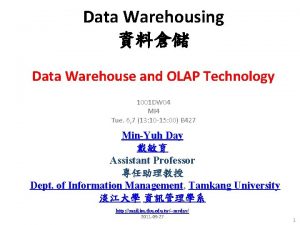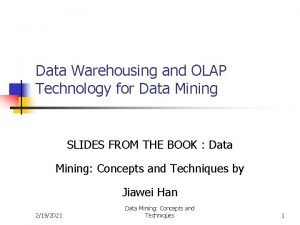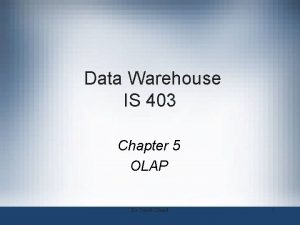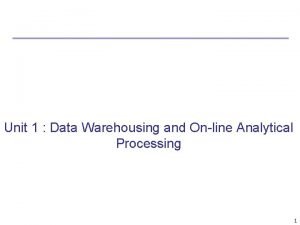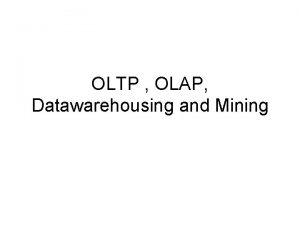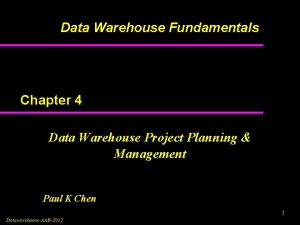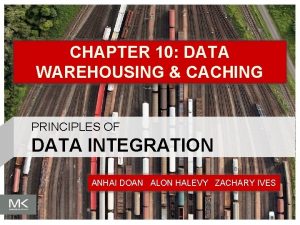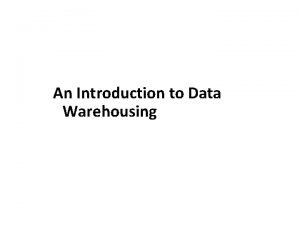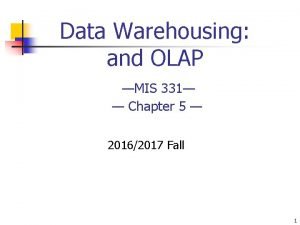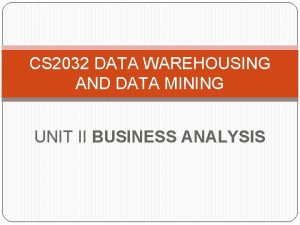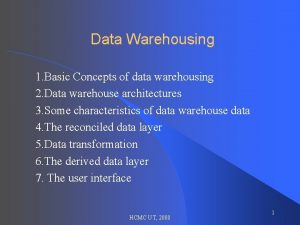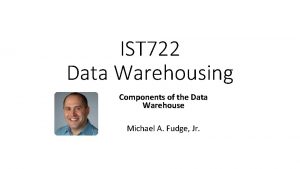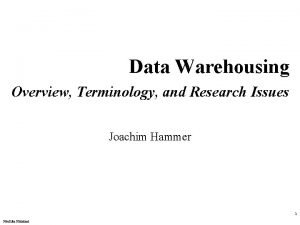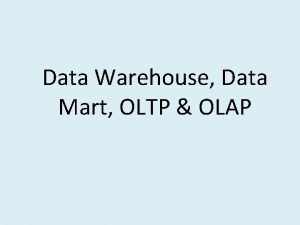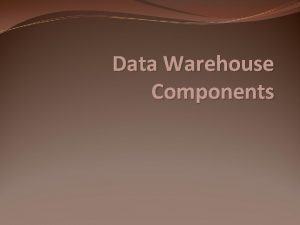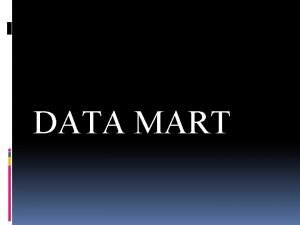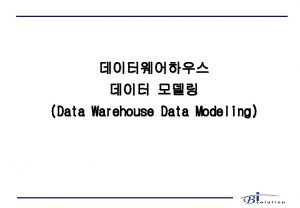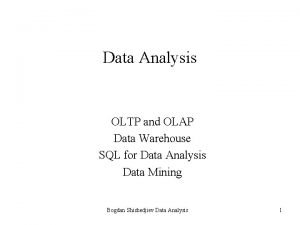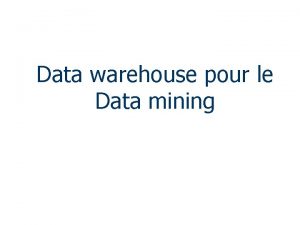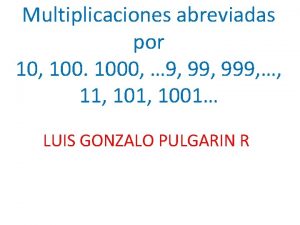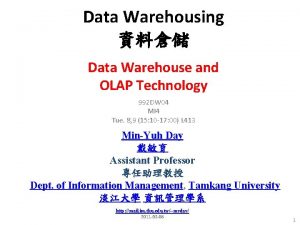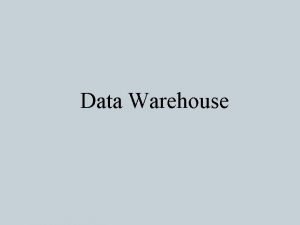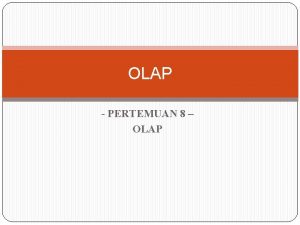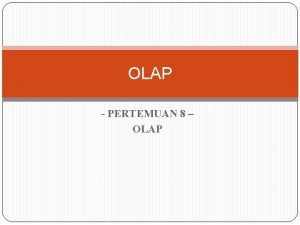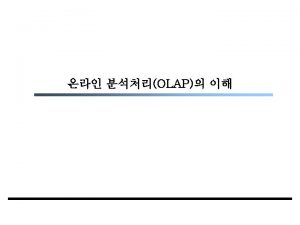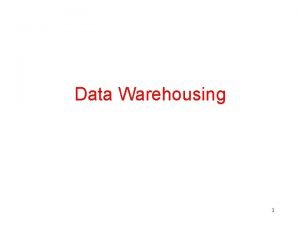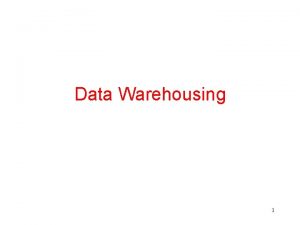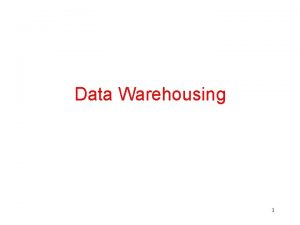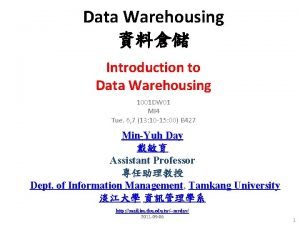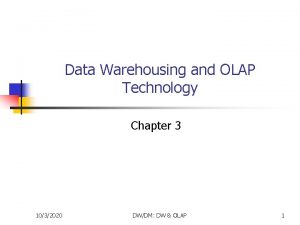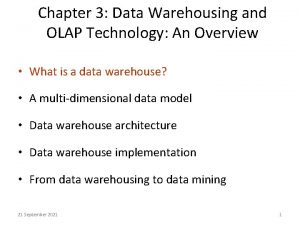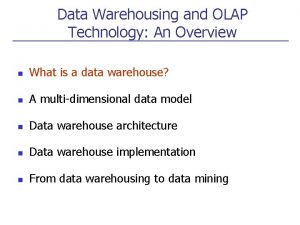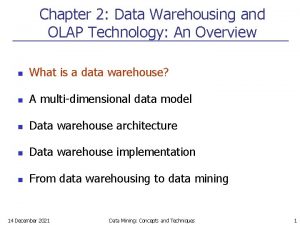Data Warehousing Data Warehouse and OLAP Technology 1001





















![Defining Star Schema in DMQL define cube sales_star [time, item, branch, location]: dollars_sold = Defining Star Schema in DMQL define cube sales_star [time, item, branch, location]: dollars_sold =](https://slidetodoc.com/presentation_image_h/a0041097eeb281fa7c69c756fd6e253d/image-22.jpg)
![Defining Snowflake Schema in DMQL define cube sales_snowflake [time, item, branch, location]: dollars_sold = Defining Snowflake Schema in DMQL define cube sales_snowflake [time, item, branch, location]: dollars_sold =](https://slidetodoc.com/presentation_image_h/a0041097eeb281fa7c69c756fd6e253d/image-23.jpg)
![Defining Fact Constellation in DMQL define cube sales [time, item, branch, location]: dollars_sold = Defining Fact Constellation in DMQL define cube sales [time, item, branch, location]: dollars_sold =](https://slidetodoc.com/presentation_image_h/a0041097eeb281fa7c69c756fd6e253d/image-24.jpg)



















![Cube Operation • Cube definition and computation in DMQL define cube sales[item, city, year]: Cube Operation • Cube definition and computation in DMQL define cube sales[item, city, year]:](https://slidetodoc.com/presentation_image_h/a0041097eeb281fa7c69c756fd6e253d/image-44.jpg)










- Slides: 54

Data Warehousing 資料倉儲 Data Warehouse and OLAP Technology 1001 DW 04 MI 4 Tue. 6, 7 (13: 10 -15: 00) B 427 Min-Yuh Day 戴敏育 Assistant Professor 專任助理教授 Dept. of Information Management, Tamkang University 淡江大學 資訊管理學系 http: //mail. im. tku. edu. tw/~myday/ 2011 -09 -27 1

Syllabus 週次 日期 內容(Subject/Topics) 1 100/09/06 Introduction to Data Warehousing 2 100/09/13 Data Warehousing, Data Mining, and Business Intelligence 3 100/09/20 Data Preprocessing: Integration and the ETL process 4 100/09/27 Data Warehouse and OLAP Technology 5 100/10/04 Data Warehouse and OLAP Technology 6 100/10/11 Data Cube Computation and Data Generation 7 100/10/18 Data Cube Computation and Data Generation 8 100/10/25 Project Proposal 9 100/11/01 期中考試週 2

Syllabus 週次 日期 10 100/11/08 11 100/11/15 12 100/11/22 13 100/11/29 14 100/12/06 15 100/12/13 16 100/12/20 17 100/12/27 18 101/01/03 內容(Subject/Topics) Association Analysis Classification and Prediction Cluster Analysis Sequence Data Mining Social Network Analysis Link Mining Text Mining and Web Mining Project Presentation 期末考試週 3

Data Warehouse and OLAP Technology • What is a data warehouse? • A multi-dimensional data model • Data warehouse architecture • Data warehouse implementation • From data warehousing to data mining Source: Han & Kamber (2006) 4

What is Data Warehouse? • Defined in many different ways, but not rigorously. – A decision support database that is maintained separately from the organization’s operational database – Support information processing by providing a solid platform of consolidated, historical data for analysis. • “A data warehouse is a subject-oriented, integrated, time-variant, and nonvolatile collection of data in support of management’s decision-making process. ”—W. H. Inmon • Data warehousing: – The process of constructing and using data warehouses Source: Han & Kamber (2006) 5

Data Warehouse • • Subject-oriented Integrated Time-variant Nonvolatile Source: Han & Kamber (2006) 6

Data Warehouse— Subject-Oriented • Organized around major subjects, such as customer, product, sales • Focusing on the modeling and analysis of data for decision makers, not on daily operations or transaction processing • Provide a simple and concise view around particular subject issues by excluding data that are not useful in the decision support process Source: Han & Kamber (2006) 7

Data Warehouse— Integrated • Constructed by integrating multiple, heterogeneous data sources – relational databases, flat files, on-line transaction records • Data cleaning and data integration techniques are applied. – Ensure consistency in naming conventions, encoding structures, attribute measures, etc. among different data sources • E. g. , Hotel price: currency, tax, breakfast covered, etc. – When data is moved to the warehouse, it is converted. Source: Han & Kamber (2006) 8

Data Warehouse— Time Variant • The time horizon for the data warehouse is significantly longer than that of operational systems – Operational database: current value data – Data warehouse data: provide information from a historical perspective (e. g. , past 5 -10 years) • Every key structure in the data warehouse – Contains an element of time, explicitly or implicitly – But the key of operational data may or may not contain “time element” Source: Han & Kamber (2006) 9

Data Warehouse— Nonvolatile • A physically separate store of data transformed from the operational environment • Operational update of data does not occur in the data warehouse environment – Does not require transaction processing, recovery, and concurrency control mechanisms – Requires only two operations in data accessing: • initial loading of data and access of data Source: Han & Kamber (2006) 10

Data Warehouse vs. Heterogeneous DBMS • Traditional heterogeneous DB integration: A query driven approach – Build wrappers/mediators on top of heterogeneous databases – When a query is posed to a client site, a meta-dictionary is used to translate the query into queries appropriate for individual heterogeneous sites involved, and the results are integrated into a global answer set – Complex information filtering, compete for resources • Data warehouse: update-driven, high performance – Information from heterogeneous sources is integrated in advance and stored in warehouses for direct query and analysis Source: Han & Kamber (2006) 11

Data Warehouse vs. Operational DBMS • OLTP (on-line transaction processing) – Major task of traditional relational DBMS – Day-to-day operations: purchasing, inventory, banking, manufacturing, payroll, registration, accounting, etc. • OLAP (on-line analytical processing) – Major task of data warehouse system – Data analysis and decision making • Distinct features (OLTP vs. OLAP): – User and system orientation: customer vs. market – Data contents: current, detailed vs. historical, consolidated – Database design: ER + application vs. star + subject – View: current, local vs. evolutionary, integrated – Access patterns: update vs. read-only but complex queries Source: Han & Kamber (2006) 12

OLTP vs. OLAP Source: Han & Kamber (2006) 13

Why Separate Data Warehouse? • High performance for both systems – DBMS— tuned for OLTP: access methods, indexing, concurrency control, recovery – Warehouse—tuned for OLAP: complex OLAP queries, multidimensional view, consolidation • Different functions and different data: – missing data: Decision support requires historical data which operational DBs do not typically maintain – data consolidation: DS requires consolidation (aggregation, summarization) of data from heterogeneous sources – data quality: different sources typically use inconsistent data representations, codes and formats which have to be reconciled • Note: There are more and more systems which perform OLAP analysis directly on relational databases Source: Han & Kamber (2006) 14

From Tables and Spreadsheets to Data Cubes • A data warehouse is based on a multidimensional data model which views data in the form of a data cube • A data cube, such as sales, allows data to be modeled and viewed in multiple dimensions – Dimension tables, such as item (item_name, brand, type), or time(day, week, month, quarter, year) – Fact table contains measures (such as dollars_sold) and keys to each of the related dimension tables • In data warehousing literature, an n-D base cube is called a base cuboid. The top most 0 -D cuboid, which holds the highest-level of summarization, is called the apex cuboid. The lattice of cuboids forms a data cube. Source: Han & Kamber (2006) 15

Cube: A Lattice of Cuboids all time 0 -D(apex) cuboid item time, location time, item location supplier item, location time, supplier location, supplier item, supplier time, location, supplier time, item, location time, item, supplier 1 -D cuboids 2 -D cuboids 3 -D cuboids item, location, supplier 4 -D(base) cuboid time, item, location, supplier Source: Han & Kamber (2006) 16

Conceptual Modeling of Data Warehouses • Modeling data warehouses: dimensions & measures – Star schema: A fact table in the middle connected to a set of dimension tables – Snowflake schema: A refinement of star schema where some dimensional hierarchy is normalized into a set of smaller dimension tables, forming a shape similar to snowflake – Fact constellations: Multiple fact tables share dimension tables, viewed as a collection of stars, therefore called galaxy schema or fact constellation Source: Han & Kamber (2006) 17

Example of Star Schema time item time_key day_of_the_week month quarter year Sales Fact Table time_key item_key branch_key branch_name branch_type location_key units_sold dollars_sold avg_sales item_key item_name brand type supplier_type location_key street city state_or_province country Measures Source: Han & Kamber (2006) 18

Example of Snowflake Schema time_key day_of_the_week month quarter year item Sales Fact Table time_key item_key branch location_key branch_name branch_type units_sold dollars_sold avg_sales Measures Source: Han & Kamber (2006) item_key item_name brand type supplier_key supplier_type location_key street city_key city state_or_province country 19

Example of Fact Constellation time_key day_of_the_week month quarter year item Sales Fact Table time_key item_key item_name brand type supplier_type location_key branch_name branch_type units_sold dollars_sold avg_sales time_key item_key shipper_key from_location branch_key branch Shipping Fact Table location to_location_key street city province_or_state country dollars_cost Measures Source: Han & Kamber (2006) units_shipped shipper_key shipper_name location_key shipper_type 20

Cube Definition Syntax (BNF) in DMQL • Cube Definition (Fact Table) define cube <cube_name> [<dimension_list>]: <measure_list> • Dimension Definition (Dimension Table) define dimension <dimension_name> as (<attribute_or_subdimension_list>) • Special Case (Shared Dimension Tables) – First time as “cube definition” – define dimension <dimension_name> as <dimension_name_first_time> in cube <cube_name_first_time> Source: Han & Kamber (2006) 21
![Defining Star Schema in DMQL define cube salesstar time item branch location dollarssold Defining Star Schema in DMQL define cube sales_star [time, item, branch, location]: dollars_sold =](https://slidetodoc.com/presentation_image_h/a0041097eeb281fa7c69c756fd6e253d/image-22.jpg)
Defining Star Schema in DMQL define cube sales_star [time, item, branch, location]: dollars_sold = sum(sales_in_dollars), avg_sales = avg(sales_in_dollars), units_sold = count(*) define dimension time as (time_key, day_of_week, month, quarter, year) define dimension item as (item_key, item_name, brand, type, supplier_type) define dimension branch as (branch_key, branch_name, branch_type) define dimension location as (location_key, street, city, province_or_state, country) Source: Han & Kamber (2006) 22
![Defining Snowflake Schema in DMQL define cube salessnowflake time item branch location dollarssold Defining Snowflake Schema in DMQL define cube sales_snowflake [time, item, branch, location]: dollars_sold =](https://slidetodoc.com/presentation_image_h/a0041097eeb281fa7c69c756fd6e253d/image-23.jpg)
Defining Snowflake Schema in DMQL define cube sales_snowflake [time, item, branch, location]: dollars_sold = sum(sales_in_dollars), avg_sales = avg(sales_in_dollars), units_sold = count(*) define dimension time as (time_key, day_of_week, month, quarter, year) define dimension item as (item_key, item_name, brand, type, supplier(supplier_key, supplier_type)) define dimension branch as (branch_key, branch_name, branch_type) define dimension location as (location_key, street, city(city_key, province_or_state, country)) Source: Han & Kamber (2006) 23
![Defining Fact Constellation in DMQL define cube sales time item branch location dollarssold Defining Fact Constellation in DMQL define cube sales [time, item, branch, location]: dollars_sold =](https://slidetodoc.com/presentation_image_h/a0041097eeb281fa7c69c756fd6e253d/image-24.jpg)
Defining Fact Constellation in DMQL define cube sales [time, item, branch, location]: dollars_sold = sum(sales_in_dollars), avg_sales = avg(sales_in_dollars), units_sold = count(*) define dimension time as (time_key, day_of_week, month, quarter, year) define dimension item as (item_key, item_name, brand, type, supplier_type) define dimension branch as (branch_key, branch_name, branch_type) define dimension location as (location_key, street, city, province_or_state, country) define cube shipping [time, item, shipper, from_location, to_location]: dollar_cost = sum(cost_in_dollars), unit_shipped = count(*) define dimension time as time in cube sales define dimension item as item in cube sales define dimension shipper as (shipper_key, shipper_name, location as location in cube sales, shipper_type) define dimension from_location as location in cube sales define dimension to_location as location in cube sales Source: Han & Kamber (2006) 24

Measures of Data Cube: Three Categories • Distributive: if the result derived by applying the function to n aggregate values is the same as that derived by applying the function on all the data without partitioning • E. g. , count(), sum(), min(), max() • Algebraic: if it can be computed by an algebraic function with M arguments (where M is a bounded integer), each of which is obtained by applying a distributive aggregate function • E. g. , avg(), min_N(), standard_deviation() • Holistic: if there is no constant bound on the storage size needed to describe a subaggregate. • E. g. , median(), mode(), rank() Source: Han & Kamber (2006) 25

A Concept Hierarchy: Dimension (location) all Europe region country city office Germany Frankfurt . . Spain North_America Canada Vancouver. . . L. Chan Source: Han & Kamber (2006) . . . Mexico Toronto M. Wind 26

View of Warehouses and Hierarchies Specification of hierarchies • Schema hierarchy day < {month < quarter; week} < year • Set_grouping hierarchy {1. . 10} < inexpensive Source: Han & Kamber (2006) 27

Multidimensional Data • Sales volume as a function of product, month, and region Dimensions: Product, Location, Time gi on Hierarchical summarization paths Re Industry Region Year Product Category Country Quarter Product City Month Week Office Day Month Source: Han & Kamber (2006) 28

2 Qtr 3 Qtr 4 Qtr od TV PC VCR sum 1 Qtr Date sum Total annual sales of TV in U. S. A. Pr U. S. A Canada Mexico Country uc t A Sample Data Cube sum Source: Han & Kamber (2006) 29

Cuboids Corresponding to the Cube all 0 -D(apex) cuboid product, date country date product, country 1 -D cuboids date, country 2 -D cuboids product, date, country Source: Han & Kamber (2006) 3 -D(base) cuboid 30

Browsing a Data Cube • Visualization • OLAP capabilities • Interactive manipulation Source: Han & Kamber (2006) 31

Typical OLAP Operations • Roll up (drill-up): summarize data – by climbing up hierarchy or by dimension reduction • Drill down (roll down): reverse of roll-up – from higher level summary to lower level summary or detailed data, or introducing new dimensions • Slice and dice: project and select • Pivot (rotate): – reorient the cube, visualization, 3 D to series of 2 D planes • Other operations – drill across: involving (across) more than one fact table – drill through: through the bottom level of the cube to its backend relational tables (using SQL) Source: Han & Kamber (2006) 32

Fig. 3. 10 Typical OLAP Operations Source: Han & Kamber (2006) 33

A Star-Net Query Model Customer Orders Shipping Method Customer CONTRACTS AIR-EXPRESS ORDER TRUCK Time PRODUCT LINE ANNUALY QTRLY DAILY Product PRODUCT ITEM PRODUCT GROUP CITY SALES PERSON COUNTRY DISTRICT REGION Location Each circle is called a footprint DIVISION Promotion Source: Han & Kamber (2006) Organization 34

Design of Data Warehouse: A Business Analysis Framework • Four views regarding the design of a data warehouse – Top-down view • allows selection of the relevant information necessary for the data warehouse – Data source view • exposes the information being captured, stored, and managed by operational systems – Data warehouse view • consists of fact tables and dimension tables – Business query view • sees the perspectives of data in the warehouse from the view of end-user Source: Han & Kamber (2006) 35

Data Warehouse Design Process • Top-down, bottom-up approaches or a combination of both – Top-down: Starts with overall design and planning (mature) – Bottom-up: Starts with experiments and prototypes (rapid) • From software engineering point of view – Waterfall: structured and systematic analysis at each step before proceeding to the next – Spiral: rapid generation of increasingly functional systems, short turn around time, quick turn around • Typical data warehouse design process – Choose a business process to model, e. g. , orders, invoices, etc. – Choose the grain (atomic level of data) of the business process – Choose the dimensions that will apply to each fact table record – Choose the measure that will populate each fact table record Source: Han & Kamber (2006) 36

Data Warehouse: A Multi-Tiered Architecture Other sources Operational DBs Metadata Extract Transform Load Refresh Monitor & Integrator OLAP Server Serve Data Warehouse Analysis Query Reports Data mining Data Marts Data Sources Data Storage OLAP Engine Front-End Tools Source: Han & Kamber (2006) 37

Three Data Warehouse Models • Enterprise warehouse – collects all of the information about subjects spanning the entire organization • Data Mart – a subset of corporate-wide data that is of value to a specific groups of users. Its scope is confined to specific, selected groups, such as marketing data mart • Independent vs. dependent (directly from warehouse) data mart • Virtual warehouse – A set of views over operational databases – Only some of the possible summary views may be materialized Source: Han & Kamber (2006) 38

Data Warehouse Development: A Recommended Approach Multi-Tier Data Warehouse Distributed Data Marts Data Mart Model refinement Enterprise Data Warehouse Model refinement Define a high-level corporate data model Source: Han & Kamber (2006) 39

Data Warehouse Back-End Tools and Utilities • Data extraction – get data from multiple, heterogeneous, and external sources • Data cleaning – detect errors in the data and rectify them when possible • Data transformation – convert data from legacy or host format to warehouse format • Load – sort, summarize, consolidate, compute views, check integrity, and build indicies and partitions • Refresh – propagate the updates from the data sources to the warehouse Source: Han & Kamber (2006) 40

Metadata Repository • Meta data is the data defining warehouse objects. It stores: • Description of the structure of the data warehouse – schema, view, dimensions, hierarchies, derived data defn, data mart locations and contents • Operational meta-data – data lineage (history of migrated data and transformation path), currency of data (active, archived, or purged), monitoring information (warehouse usage statistics, error reports, audit trails) • The algorithms used for summarization • The mapping from operational environment to the data warehouse • Data related to system performance – warehouse schema, view and derived data definitions • Business data – business terms and definitions, ownership of data, charging policies Source: Han & Kamber (2006) 41

OLAP Server Architectures • Relational OLAP (ROLAP) – Use relational or extended-relational DBMS to store and manage warehouse data and OLAP middle ware – Include optimization of DBMS backend, implementation of aggregation navigation logic, and additional tools and services – Greater scalability • Multidimensional OLAP (MOLAP) – Sparse array-based multidimensional storage engine – Fast indexing to pre-computed summarized data • Hybrid OLAP (HOLAP) (e. g. , Microsoft SQLServer) – Flexibility, e. g. , low level: relational, high-level: array • Specialized SQL servers (e. g. , Redbricks) – Specialized support for SQL queries over star/snowflake schemas Source: Han & Kamber (2006) 42

Efficient Data Cube Computation • Data cube can be viewed as a lattice of cuboids – The bottom-most cuboid is the base cuboid – The top-most cuboid (apex) contains only one cell – How many cuboids in an n-dimensional cube with L levels? • Materialization of data cube – Materialize every (cuboid) (full materialization), none (no materialization), or some (partial materialization) – Selection of which cuboids to materialize • Based on size, sharing, access frequency, etc. Source: Han & Kamber (2006) 43
![Cube Operation Cube definition and computation in DMQL define cube salesitem city year Cube Operation • Cube definition and computation in DMQL define cube sales[item, city, year]:](https://slidetodoc.com/presentation_image_h/a0041097eeb281fa7c69c756fd6e253d/image-44.jpg)
Cube Operation • Cube definition and computation in DMQL define cube sales[item, city, year]: sum(sales_in_dollars) compute cube sales • Transform it into a SQL-like language (with a new operator cube by, introduced by Gray et al. ’ 96) () SELECT item, city, year, SUM (amount) (city) FROM SALES (item) (year) CUBE BY item, city, year • Need compute the following Group-Bys (city, item) (city, year) (item, year) (date, product, customer), (date, product), (date, customer), (product, customer), (date), (product), (customer) (city, item, year) () Source: Han & Kamber (2006) 44

Iceberg Cube • Computing only the cuboid cells whose count or other aggregates satisfying the condition like HAVING COUNT(*) >= minsup n Motivation n Only a small portion of cube cells may be “above the water’’ in a sparse cube n Only calculate “interesting” cells—data above certain threshold n Avoid explosive growth of the cube n Suppose 100 dimensions, only 1 base cell. How many aggregate cells if count >= 1? What about count >= 2? Source: Han & Kamber (2006) 45

Indexing OLAP Data: Bitmap Index on a particular column Each value in the column has a bit vector: bit-op is fast The length of the bit vector: # of records in the base table The i-th bit is set if the i-th row of the base table has the value for the indexed column • not suitable for high cardinality domains • • Base table Index on Region Source: Han & Kamber (2006) Index on Type 46

Indexing OLAP Data: Join Indices • Join index: JI(R-id, S-id) where R (R-id, …) S (S-id, …) • Traditional indices map the values to a list of record ids – It materializes relational join in JI file and speeds up relational join • In data warehouses, join index relates the values of the dimensions of a start schema to rows in the fact table. – E. g. fact table: Sales and two dimensions city and product • A join index on city maintains for each distinct city a list of R-IDs of the tuples recording the Sales in the city – Join indices can span multiple dimensions Source: Han & Kamber (2006) 47

Efficient Processing OLAP Queries • Determine which operations should be performed on the available cuboids – Transform drill, roll, etc. into corresponding SQL and/or OLAP operations, e. g. , dice = selection + projection • Determine which materialized cuboid(s) should be selected for OLAP op. – Let the query to be processed be on {brand, province_or_state} with the condition “year = 2004”, and there are 4 materialized cuboids available: 1) {year, item_name, city} 2) {year, brand, country} 3) {year, brand, province_or_state} 4) {item_name, province_or_state} where year = 2004 Which should be selected to process the query? • Explore indexing structures and compressed vs. dense array structs in MOLAP Source: Han & Kamber (2006) 48

From data warehousing to data mining Source: Han & Kamber (2006) 49

Data Warehouse Usage • Three kinds of data warehouse applications – Information processing • supports querying, basic statistical analysis, and reporting using crosstabs, tables, charts and graphs – Analytical processing • multidimensional analysis of data warehouse data • supports basic OLAP operations, slice-dice, drilling, pivoting – Data mining • knowledge discovery from hidden patterns • supports associations, constructing analytical models, performing classification and prediction, and presenting the mining results using visualization tools Source: Han & Kamber (2006) 50

From On-Line Analytical Processing (OLAP) to On Line Analytical Mining (OLAM) • Why online analytical mining? – High quality of data in data warehouses • DW contains integrated, consistent, cleaned data – Available information processing structure surrounding data warehouses • ODBC, OLEDB, Web accessing, service facilities, reporting and OLAP tools – OLAP-based exploratory data analysis • Mining with drilling, dicing, pivoting, etc. – On-line selection of data mining functions • Integration and swapping of multiple mining functions, algorithms, and tasks Source: Han & Kamber (2006) 51

An OLAM System Architecture Mining query Mining result Layer 4 User Interface User GUI API OLAM Engine OLAP Engine Layer 3 OLAP/OLAM Data Cube API Layer 2 MDDB Meta Data Filtering&Integration Database API Filtering Layer 1 Databases Data cleaning Data integration Warehouse Source: Han & Kamber (2006) Data Repository 52

Summary: Data Warehouse and OLAP Technology • Why data warehousing? • A multi-dimensional model of a data warehouse – Star schema, snowflake schema, fact constellations – A data cube consists of dimensions & measures • OLAP operations: drilling, rolling, slicing, dicing and pivoting • Data warehouse architecture • OLAP servers: ROLAP, MOLAP, HOLAP • Efficient computation of data cubes – Partial vs. full vs. no materialization – Indexing OALP data: Bitmap index and join index – OLAP query processing • From OLAP to OLAM (on-line analytical mining) Source: Han & Kamber (2006) 53

References • Jiawei Han and Micheline Kamber, Data Mining: Concepts and Techniques, Second Edition, 2006, Elsevier • Efraim Turban, Ramesh Sharda, Dursun Delen, Decision Support and Business Intelligence Systems, Ninth Edition, 2011, Pearson. 54
 An overview of data warehousing and olap technology
An overview of data warehousing and olap technology An overview of data warehousing and olap technology
An overview of data warehousing and olap technology Olap database
Olap database Data warehouse and olap technology
Data warehouse and olap technology Data warehouse and olap technology
Data warehouse and olap technology Deklarasi pointer
Deklarasi pointer Olap architecture diagram
Olap architecture diagram 3 layers of data warehouse architecture
3 layers of data warehouse architecture What is kdd process in data mining
What is kdd process in data mining Analitical cubism
Analitical cubism Introduction to data warehouse
Introduction to data warehouse Hive provides data warehousing layer to data over hadoop.
Hive provides data warehousing layer to data over hadoop. Best practices data warehousing
Best practices data warehousing Starnet query model in data warehouse
Starnet query model in data warehouse Olap vs oltp in data mining
Olap vs oltp in data mining Operational and informational data store in data warehouse
Operational and informational data store in data warehouse Greenplum data warehousing
Greenplum data warehousing Data warehouse component
Data warehouse component Data warehouse project charter
Data warehouse project charter 1keydata data warehousing
1keydata data warehousing Data warehousing principles
Data warehousing principles Introduction to data warehouse
Introduction to data warehouse Concept hierarchy in data warehousing
Concept hierarchy in data warehousing Cognos impromptu in data warehousing
Cognos impromptu in data warehousing Basic concept of data warehousing
Basic concept of data warehousing Inmon cif
Inmon cif Research problems in data warehousing
Research problems in data warehousing Healthcare data warehousing
Healthcare data warehousing Front room vs backroom data warehousing
Front room vs backroom data warehousing Contoh data warehouse dan data mart
Contoh data warehouse dan data mart Components in data warehouse
Components in data warehouse Perbedaan data warehouse dan data mart
Perbedaan data warehouse dan data mart Perbedaan data warehouse dan data mining
Perbedaan data warehouse dan data mining Data mining dan data warehouse
Data mining dan data warehouse What is data acquisition in data warehouse
What is data acquisition in data warehouse Prinsip data warehouse
Prinsip data warehouse Data warehouse dan data mining
Data warehouse dan data mining Olap facts and dimensions
Olap facts and dimensions Oltp and olap in sql
Oltp and olap in sql Slicing and dicing in olap
Slicing and dicing in olap Hasil konversi bilangan biner 1001
Hasil konversi bilangan biner 1001 Rtd/atu 1001 pension plan
Rtd/atu 1001 pension plan Multiplicaciones abreviadas ejemplos resueltos
Multiplicaciones abreviadas ejemplos resueltos Game design documents
Game design documents Five major terrain features
Five major terrain features Nfpa 1001 2019
Nfpa 1001 2019 Considere todos os numeros inteiros entre 101 e 1001
Considere todos os numeros inteiros entre 101 e 1001 081-com-1001
081-com-1001 1001 stars
1001 stars Imgd model
Imgd model 1001 pennies problem answer
1001 pennies problem answer 0001 1111
0001 1111 011 101 110
011 101 110 Blinde darm operatie
Blinde darm operatie Mealy sequence detector 1001
Mealy sequence detector 1001



